18″ radomes #4, the wet edition
Things didn’t work out as hoped for yesterday — via Nexrad the rain cells appeared to dissipate well to the west, and then when it did pour unexpectedly (the Camden Hills really limit our western view here) I wasn’t ready to get underway — but I did get a taste of how the four 18-inch radomes handle precip, and I did get wet. It seems to me that radar should ideally do two somewhat contradictory things in rain: cut through it to show real targets, but also show distant cells so you might maneuver around them. The Furuno DRS2 did quite well on both counts…
Of course it helps a great deal that the Furuno UHD can show two completely independent ranges at once. (This is a terrific feature for many uses, but note that the DRS2 retails for $2,600). Rain clutter is in auto mode on the left side of the screen below, and the target imaging is almost as good as it is in clear air. (Note that the DRS2 has a .0625nm range — aka, 1/16th, or 400′ — which is only seen otherwise on the BR24, though it doesn’t seem to resolve targets at that near range quite as well as the Broadband.) On the right side, at 8nm range, the Furuno clearly targeted islands behind me at 4 and 8 miles (the long low views in other directions are fairly blocked in Camden Inner Harbor) and picked up a bit of the cells behind the hills at 2-5 miles ahead of the boat. That was in auto mode; here, I’m tweaking Rain clutter to show more of the heavy precip cells, which show nicely in green. With this technique I was able to watch that rain move past me and all the way to North Haven, the red target 8 miles behind. Pretty amazing for a 2.2 kW radar whose scanner is less than 17″ long, what?
 The Navico BR24 also did a good job of seeing through rain at very close and medium ranges in auto mode. In fact, I had to fool with the Rain Clutter control to see rain at all, though that didn’t help much beyond a few miles, at least in this confined location.
The Navico BR24 also did a good job of seeing through rain at very close and medium ranges in auto mode. In fact, I had to fool with the Rain Clutter control to see rain at all, though that didn’t help much beyond a few miles, at least in this confined location.
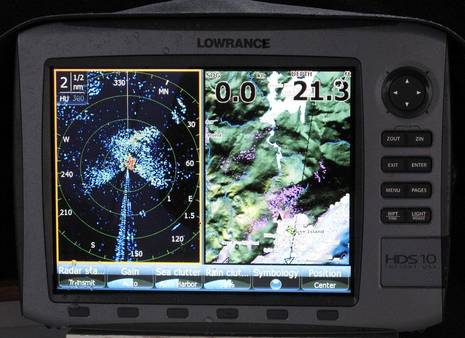 The Garmin GMR 18 HD also cut through the downpour well at close ranges, but I was a little surprised when I ranged out to 8 miles, as seen below. The photo is poor, but it really did seem to have trouble filtering out the rain without manual tuning and then it seemed to lose some real targets too.
The Garmin GMR 18 HD also cut through the downpour well at close ranges, but I was a little surprised when I ranged out to 8 miles, as seen below. The photo is poor, but it really did seem to have trouble filtering out the rain without manual tuning and then it seemed to lose some real targets too.
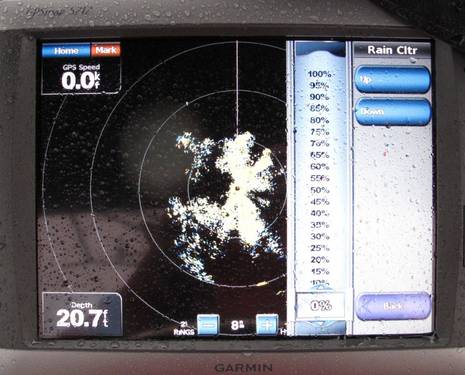 I only got a few minutes with the Raymarine RD418D, due to some power issues (probably of my own doing), but it seemed to image the rain cells well at distance. Obviously this was a limited and tentative test of the radomes in rain, and I strongly caution against drawing major conclusions. But it sure is looking like Furuno managed to pack a heck of a performance/feature mix into the wee DRS2.
I only got a few minutes with the Raymarine RD418D, due to some power issues (probably of my own doing), but it seemed to image the rain cells well at distance. Obviously this was a limited and tentative test of the radomes in rain, and I strongly caution against drawing major conclusions. But it sure is looking like Furuno managed to pack a heck of a performance/feature mix into the wee DRS2.


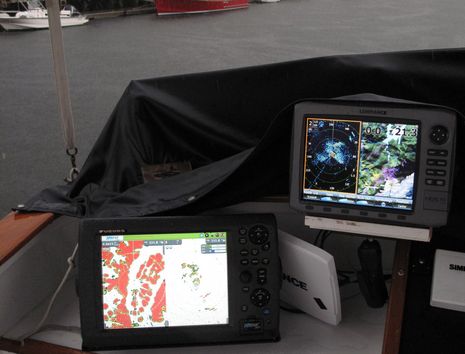

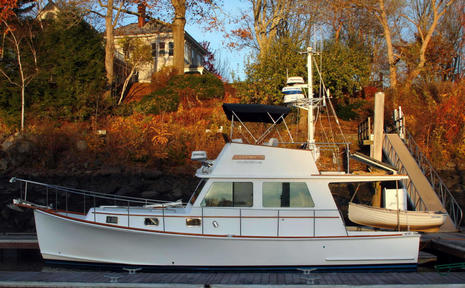

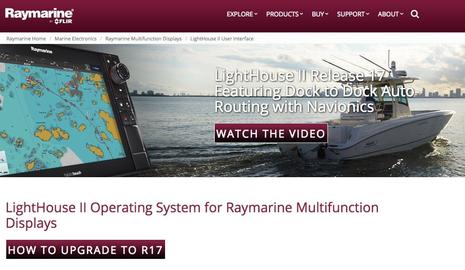







No Panbo comments all day on this topic?
I for one find this very intriguing Ben.
Excellent work Ben! As the radar looks farther into a rain cell the size of the beam is constantly increasing in volume for a fixed range gate length. Think of a set of disks that are one range gate deep and as big around as the antenna beamwidth. Diameter is Range x 0.017 x Beamwidth in degrees. So 8 x 0.017 x 5 degrees = 0.68 Nmile.
The return from rain will increase as the volume of the disk increases. So for high range resolution the disk is kept thin and restricts the volume of rain return. That favors the BR24 – the Furuno can also benefit if they use multiple pulse lengths and keep the pulse length as short as possible for as long as possible. There are other methods of reducing rain clutter as well – and they can be sophisticated.
I’m looking forward to more – you have begun a very good study here. I’m traveling overseas on business – will get back to you on this asap.
I find it amazing that the Furuno DRS radar with half the output power is detecting long range targets as well as, if not better than, the others. The others can’t all be broken or have problems.
I could understand if someone like myself had installed and tested it.
Good for Furuno even if it is more expensive. My friend told me that they always win radar awards and now I can see why they do. I guess that’s why I always see Furuno radars on the local USCG boats and the Commercial Boats in my area.
Sam
Hang on, Sam; I didn’t say that the Furuno does better at long range than the 4 kW Garmin and Raymarine domes. It doesn’t reach quite as far (in my testing so far, which may be cruder than you think). But the difference is much less than the 2.2 vs 4 kW might suggest. Screenshots soon.
I believe that even the ray c and e series can do split screen radars at two scales simultaneously. Correct me if I am wrong,
Pardon my ignorance and hopefully somebody will answer this layman question. I am sort of married to Raymarine because everything on board Bremer Speck is theirs. E120/E80, ST60/ST70s etc. – I now have their analog RD424 and am considering upgrading to the digital version. What I do not understand is, what is the difference, generally speaking, if any, between a Raymarine digital radome and, let’s say, a Garmin HD radome? HD to me means “high definition” so is Raymarine missing out on this in their radome? I have asked Raymarine for clarification but perhaps the mention of a competitor name upset them because I have not heard back. 🙁
Cheers,
Ronald
Ben,
I clicked on all of the pictures to blow them up and have some questions.
I’m pretty sure I understand your explanation on the Furuno radar and I can see the island at about 8 miles and it shows the intensity of the rain cells.
I can’t understand the Garmin picture. It all looks the same to me.
In other words, I believe I could navigate around the intense cells if I saw the Furuno picture but, I wouldn’t know what to do if I saw the Garmin picture. I would understand if the rain clutter wasn’t set to zero and did the Furuno look the same with the rain clutter set to zero?
Can you explain it to me?
Steve
Skipper150,
I would not hesitate to stay with Raymarine. As Ben shows there are differences, but the main point I think he wants to make is that all these new-generation scanners are a lot better than the old ones.
Whether the marketing departments stick High Definition on it is just ’cause they want to associate them with a buzzword that is “in vogue” right now because of the move from old analog TV to “HD digital” (720p or 1080i) TV.
In radar technology the situation is not as clear cut. You cannot say that a radar screen resolves at a certain amount of pixels, as you can see from DaveV’s posts whose knows a heck more about the radar side of things.
What these new radars do all have is a small embedded processor in the radome that takes the analog data coming from the scanner itself, convert it to digital and then do some transformations on this digital data to enhance it. Then they send out the finished product as packets over Ethernet. Usually the output is a fixed number of pixels for a fixed number of different bearings.
This means reduced installation problems, as there is no longer a thick cable carrying several coax cables and high voltages running through your boat, but just a highly resilient and much smaller Ethernet cable (plus power). It also means less chance of problems where the cable develops a fault.
The HD probably stems from the marketing people overhearing the engineers about how many pixels are transmitted per bearing, which can be impressively high but does not mean that the scanner and electronics are actually able to present images in that particular resolution. Compare this to the amount of pixels in small digital cameras, which is getting ridiculous (12 Mp in a cell phone!) as there is no way the plastic itty bitty lenses can cope.
As DaveV has explained, there’s just so much you can get in range and angular resolution from a 18″ scanner.
So I’d say, if you’ve got Ray all over just stick with it and don’t worry about the relative performance with different brands.
SanderO, Thanks for bringing this up. C-Series can definitely do dual range with Raymarine’s open array HD and SHD scanners, but it’s unclear if the Digital radomes support this feature. The C manual suggests that all “Digital” radars do it, but dual range is not listed as a Digital radome feature. Plus, Raymarine seems to have some limits to its dual range that Furuno doesn’t, like no MARPA while in dual range, and having to choose by menu whether the second range is “Long” or “Short”.
Ronald, as far as I can tell there are no standards as to what Digital, HD, etc. means, beyond the fact that all such radars seem to use Ethernet for output. I believe that there are dozens, if not hundreds, of clever hardware and software techniques that the engineers are using to massage radar signals once they are digitized, and thus the real world performance of all these new scanners varies a lot, as does their feature sets.
Steve, Sorry if I was confusing. The 8nm Furuno image has its auto rain clutter control slightly tweaked to show more rain; in full auto mode, it filtered out all but the most intense returns. The Garmin screen is what I saw when I ranged out to 8nm; I was able to use the Rain control to make more sense of it, but it seemed like it effected the more intense yellow targets too. Yesterday I realized that Garmin uses an old fashioned FTC (Fast Time Constant) setting for long range rain clutter. I hope to try that when I get another rainy session, but regardless Garmin seems to have a ways to go to make this scanner easy to use in rain. Let’s not forget, though, that it’s nearly half the price of the Furuno, and is quite easy to use in many ways.
I hadn’t seen Kees’ comment when I wrote mine, and I agree with him almost 100%. But I have been talking with Furuno, and they seem to be doing a few things differently, and the results are showing up in this testing:
* “The Furuno MFD8/12s use a more expensive Field Programmable Gate Array (FPGA) High Speed Processor to redraw the radar image line-by-line.” There’s definitely a qualitative difference in target imagery, which shows up better in photos I haven’t put up yet. (Amazingly, the Furuno NN3D displays can not take screenshots yet, which makes them the last holdout, I think, though Garmin doesn’t make it easy.)
* “The number of scan lines of the DRS are truly high definition and match our commercial radars in this respect.” Scan lines might be an HD specification that’s meaningful, though I can’t say I understand what they mean yet 😉 But I’m told that scan lines is what Garmin is talking about when they claim that their new xHD open arrays yield “eight times more sampling data”.
https://panbo.com/archives/2009/07/garmin_vhf_300_ais_xhd_radar_more.html
* Furuno tells me that it’s the only manufacturer in this comparison which makes its own MIC (Microwave Transmitter/Receiver), and that the receiver has “about 3dB better detection performance” than the components the competitors purchase. This would account for how they get 2.2 kW of transmit power to reach nearly as far as 4kW.
Ben, I don’t doubt that Furuno has excellent digital parts, but as an electrical engineer I’m not impressed by claims that they use a FPGA. I’m not sure of the maths involved, but a generic DSP might be even better at doing analysis/transformation, and has the added benefit of being able to be reprogrammed using a firmware update.
I totally believe you when you say that the Furuno is better than the others. I’d say the most likely reason is their analog part, i.e. the MIC. Building analog electronics is an art, and only a few companies have this down. One reason to go digital is that it makes it easier to build electronic systems!
As to “number of scan lines”, this just proves my point: it’s easier for them to produce a range of digital stuff that all pumps out the same amount of bits / second. Even at artificially high rates it will not saturate a 100 MBit Ethernet link, and the digital parts are pretty cheap. There is no economic reason to send lower amounts of data. However, that still does not mean that there is any substance behind it. And yes, with the Furuno there is probably a little more substance but that’s because they start out with a better receiver.
PS. My 5 yr old Koden MDS-51R RadarPC box has a FPGA, and supports 1024 scan lines per rotation each of 256 data points. I doubt that the recent crop of radars uses much more. Note how none of them seem to be willing to reveal how much data they actually calculate with.
I have a new Garmin 4212 with GMR 24 HD radar. In my opinion, target definition is not what I would call “High Definition”. In fact, my twenty year old Furuno 1800 had better defined target edges then the new radar. I think manufacturers that use the term “High Definition” are shooting themselves in the foot since the public already has seen high definition TV and expects the same crystal clear resolution from their, so called, HD radar which just isn’t happening. Beside my disappointment with the radar picture I liked manually dialing in adjustments on the old radar instead of digging through an on screen menu. it was just faster with the dial controls and I was able to see what happened to the targets as I made a quick combination of dial changes.
I’m impressed by that little Furuno radar. The dual ranges looks good. Can you do dual radar overlayed on the chart?
I have used the larger Furuno FAR2137 radar and they also use FPGA’s, but they are a little more expensive than the DRS2D…..
Does anyone see a big difference between the garmin 18HD and the 24HD?
Same question as Florist… any differences at short rtange between the 18HD and 24HD? More importantly, any differences that you’ve been able to see between the 18HD and the 24 non-HD? Would you choose the more narrow beam width of the 24 non-HD, or the software tricks of the 18HD?
My primary use is just 1-2 miles out, collision avoidance.
I swapped the 18HD for the 24HD, thus never got to see them in the same place and conditions, and so my comparison is more subjective than the side by side testing I did (which was still subjective to some degree). That said, the 24HD is better, no doubt, but I was somehow hoping for a bigger performance jump. I’ve not tried either of non HD radomes and sort of wonder why they exist given the $200 retail price difference.
I’d always choose a 24 radome over an 18 as long as I had the room and the price step wasn’t outrageous. Digital processing has blurred the importance of beam width and pulse power, but a narrow beam is still better. The much harder choice is between good radars like the Garmins and amazing ones like those Furuno has developed, with Raymarine hot in pursuit. The cost difference is not trivial, and of course it’s a whole MFD system decision.
One more thing about the Garmins: I don’t think they are quite the same generation, the 24HD coming out after the 18HD. Which means there may be more performance difference than other 24/18 pairs. I didn’t really notice a dramatic difference, but that doesn’t mean it isn’t there.
I would not hesitate to stay with Raymarine. As Ben shows there are differences, but the main point I think he wants to make is that all these new-generation scanners are a lot better than the old ones.